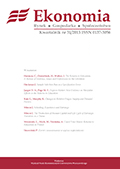Modelowanie i prognozowanie zmienności przy użyciu modeli opartych o zakres wahań
T. Skoczylas
ABSTRAKT: This paper shows advantages of using price range in volatility modeling and forecasting. It is known that price range, defined as a difference between the logarithms of the highest and the lowest price of an asset, is a useful volatility approximation. In this paper three different range-based models are compared with commonly used residual-based GARCH model in terms of goodness of fit and forecasting accuracy. Each model is estimated on daily data covering six currency pairs quoted to PLN. Despite being equally simple as residual-based GARCH model, range-based models generally perform better. Forecasts generated by range-based models are more precise, moreover they seems to better capture volatility clustering phenomenon.
Pełny tekst (PDF)
Numer wydania: 35
W numerze:
Housing market cycles – a disequilibrium model and its application to the primary housing market in Warsaw
H. Augustyniak, J. Łaszek, K. Olszewski, J. Waszczuk
ABSTRAKT |
PDF
This paper presents a simple disequilibrium model in the primary housing market, calibrated to the Warsaw market. Our aim is to point out that the primary housing market, due to the long construction process is always in disequilibrium, which has important policy implications. We discuss the last housing cycle and show how a combination of slight demand shocks with short-term rigid supply leads to strong fluctuations of house prices and new construction. The primary market can create a significant distress to the economy, because when house prices rise, this sector attracts capital and workers and is able to generate excessive supply, which finally can lead to the burst of the price bubble. The cyclical character is a permanent feature of the property market and can be explained by the inelasticity of supply. Market participants form price and demand expectations based on past observations. This causes frequent cycles that, under specific conditions, can lead to economic crises. We believe that the model describes the reality of the primary housing market better than equilibrium models do, so it can be useful for central banks and financial supervision institutions in the analysis of the impact of fiscal and monetary policy and regulations on the real estate market.
Spatial Prediction Models for Real Estate Market Analysis
K. Chrostek, K. Kopczewska
ABSTRAKT |
PDF
The econometric modeling of real estate prices is an important step in their valuation. As shown in the theory and practice of valuation, the most important determinant of these prices is location. Therefore, models comprising the spatial components give better estimates than a-spatial models. The purpose of this paper is to compare the quality of prediction for several models: a classical linear model estimated with OLS, linear OLS model including geographical coordinates, Spatial Expansion model, spatial lag and spatial error models, and geographically weighted regression. The evaluation will be based on the calibrated models for the real estate market data in Wroclaw in 2011. The study confirms that the inclusion of the spatial aspect of the analysis may result in improvement in the quality of models. Best fit to the data among the presented methods has proved a geographically weighted regression.
Enforced compatibility and control of switching costs in markets with network externalities: an experiment
T. Kopczewski, M. Krawczyk, P. Kusztelak
ABSTRAKT |
PDF
We experimentally investigate two competition policy measures relevant for markets with network externalities: mandating technological compatibility and lowering the cost of switching between providers. We do so in a virtual market with the roles of both sellers and buyers being played by student subjects. We find only limited support for usefulness of the analyzed measures: our treatment manipulations have no effect on sellers’ pricing strategies. They do, however, reduce individual lock-in, helping the buyers to obtain the currently cheaper variant and thus increase customers’ welfare.
Modelowanie i prognozowanie zmienności przy użyciu modeli opartych o zakres wahań
T. Skoczylas
ABSTRAKT |
PDF
This paper shows advantages of using price range in volatility modeling and forecasting. It is known that price range, defined as a difference between the logarithms of the highest and the lowest price of an asset, is a useful volatility approximation. In this paper three different range-based models are compared with commonly used residual-based GARCH model in terms of goodness of fit and forecasting accuracy. Each model is estimated on daily data covering six currency pairs quoted to PLN. Despite being equally simple as residual-based GARCH model, range-based models generally perform better. Forecasts generated by range-based models are more precise, moreover they seems to better capture volatility clustering phenomenon.
Pośrednie determinanty wzrostu w kontekście nierówności dochodowych – wspierać edukację czy przeciwdziałać przestępczości?
M. Smyk, J. Tyrowicz
ABSTRAKT |
PDF
Nierówności dochodowe są jednym z najczęściej pojawiających się problemów społecznych w kontekście wzrostu gospodarczego państwa. Jak wskazuje literatura teoretyczna związek między rozwarstwieniem a wzrostem gospodarczym nie jest bezpośredni. Wśród kanałów, przez które zjawiska te oddziałują na siebie wymieniane są między innymi edukacja, poziom inwestycji czy przestępczość. Wyniki badania empirycznego przeprowadzonego na danych dotyczących stu dwudziestu krajów (ze szczególną uwagą zwróconą na kraje biedniejsze) w latach 1960-2009 nie potwierdziły jednak hipotez dotyczących znaczenia tych czynników jako kanałów wpływu nierówności dochodowych na wzrost gospodarczy.
Badanie zwrotu z mobilności zawodowej w Polsce
P. Strawiński, M. Wroniewicz
ABSTRAKT |
PDF
Praca podejmuje problematykę zwrotu z mobilności zawodowej w Polsce. Korzystając z kwartalnych danych panelowych BAEL od początku 2008 roku do drugiego kwartału 2010 roku zbadano wpływ zmiany miejsca pracy, w obrębie tego samego sektora oraz pomiędzy branżami, na wzrost płac. Uwzględniono problem nieobserwowalnej heterogeniczności oraz endogeniczności posługując się modelem efektów stałych oraz metodą Difference-In-Differences Propensity Score Matching.

